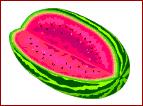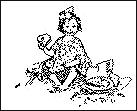"Mother's Watermelon"
in
THOSE WERE THE DAYS
in Montana in the mid 1920s - 1930s
written by Lillian Hein Remmick
Copyrighted 1999
All rights are reserved. This story, or parts thereof, may not be reproduced in any form without permission. Published by Remick-Hubert Corp.221 Main Streeet, Suite 1300, San Francisco, California, 94105
-
Mother loved her water melon patch and every year she would save seeds from the best melons to plant the following year.
Her watermelon patch was large and well known so we kept a close eye on the patch when the melons began to ripen.
One Sunday evening when Mother and Dad went to attend prayer meeting at church we were given strict orders to keep a close watch on the watermelon patch.
My older sister, young brother, myself and the neighbor boy were left to watch the melon patch.
It was getting quite dark when we noticed a light coming toward the melon patch so we decided to scare the thieves.
We took a gun, probably a twenty two rifle, and from the upstairs window we shot high over the melon patch. We assumed that by shooting high we wouldn't hurt anyone, just scare them.
The light went out and we gave ourselves a so called pat on the back as we were feeling like we had accomplished our mission.
The next morning the neighbor lady came to visit and reported to Mother that someone had nearly shot her the previous night . The bullet had just barely missed her.
She said she had gone to fix their gate after dark which was on a rise on the other side and well away from the patch so when we shot high we nearly hit her.
The four of us were very quiet.
We were very glad she wasn't hurt.
We never tired anything like that again.
Mother would, also, in the fall, pick small round green watermelons which she washed and placed in a twenty gallon crock over which she poured a pickling brine. Over this would go a large plater with a large clean rock to hold. the melon in the brine. Over this she would tie a large whit dish towel.
By winter, the melons would have ripened in the brine and Mother would slice them thinly and place them on a plater. They had a wonderful sweet sour taste.
Darn, I've really made my mouth water just thinking about this.
My Mother is long gone and only the memory remains.
Thanks to Mother we ate well.
Approximate measurments of my Mother's recipe were: to every two and one-half gallons of spring water she added two cups of pickling salt. As she layered the melons she would pour enough brine to cover each layer, sprinkle a small handful of pickling spice and about give stalks of dill (seed tops and all). This she repeated until the crock was full. If necessary she would make more brine to fill the crock to the top. Garlic cloves may be added.
The crock sat side by side in the cellar full of other pickled items such as sourkraut, pickles..... There was, also, brautwerst covered with rendered lard.
The End
I remember the special jars packed with pickles meant for the Country and State Fair here in California back in the late 1940s and 1950s. They were not just stuffed with just watermelons or just pickles which then taken out an tasted by the judges. These jars filled with works of created art. The vegetables such as carrots, onions and cauliflower with the pickles were formed into pictures such as a farm house with a picket fence or a barn... even human-like faces. Nothing like the pickles jars I buy at the store in April of the year 2000.
In the last ten years, I think I've only made one batch of pickles which the taste even came close to what my mother and grandmother made and that was with the help of my ex-daughter-in-law, and still friend, Erica Hubert
Other Web Sites For Recipes recommended by my viewers:
Book all about melons. See Amy Goldman's web site: http://www.agoldthumb.com
MT Home Site
http://www.remmick.org/Montana.Menories/Page7.html


